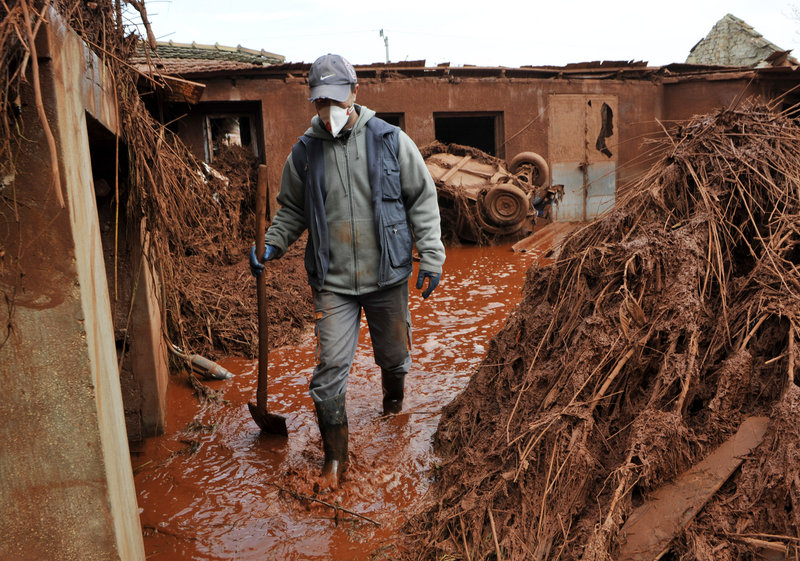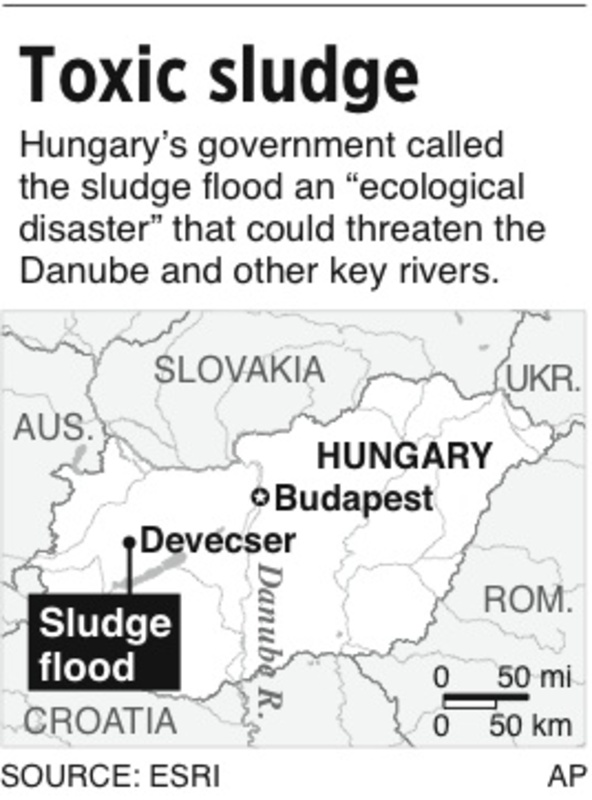KOLONTAR, Hungary – There was no stopping the avalanche of toxic red sludge: It smashed through the door of Kati Holczer’s house, trapping the mother and her toddler in a sea of caustic waste.
She saved her 3-year-old son, Bence, by placing him on a sofa that was floating in the muck. Then she called her husband, Balazs, who was working in Austria, to say goodbye.
“We’re going to die,” she told him, chest-deep in the acrid mud.
After the terror came the pain: Holczer and her two rescuers were among dozens of villagers suffering from deep chemical burns following Monday’s spill.
Their fox terrier Mazli — his name means “Luck” in Hungarian — lay dead in the yard Wednesday, still chained to a stake. Luca, their Labrador, was swept away by the 9-foot-high wave of toxic waste that poured from a breached reservoir at a nearby alumina factory.
The ecological catastrophe that is threatening the Danube River — one of Europe’s main waterways — has left a trail of shattered lives.
On Wednesday, furious villagers, their shoes splattered with the caustic red mud, crowded around an official of the company blamed for the disaster and demanded compensation for destroyed homes, fields and livelihoods. Authorities have ordered a criminal inquiry into the accident, which killed at least four people, injured 120 and left three people missing.
After bursting from the reservoir and flooding three villages Monday, the sludge — a waste product of aluminum production that can contain heavy metals — ended up in the Marcal River, part of the tributary system feeding the Danube, some 45 miles to the north. Hundreds of people were evacuated.
Local streams were swollen Wednesday and tinted ochre by the sludge, and residents said they were empty of fish.
Imre Szakacs, head of the county crisis management committee, told the state-run MTI news agency the lye-like slurry was expected to reach the Danube by the weekend or early next week. Chemical analyses of the sludge were ongoing Wednesday.
However, Kolontar Mayor Karoly Tili said the material was not radioactive as feared. “We can say for sure that according to the measurements there is no radioactivity,” he said.
Still, concerns grew about damage to marine life in the region and beyond. South of Hungary, the 1,775-mile Danube flows through Croatia, Serbia, Romania, Bulgaria, Ukraine and Moldova before emptying into the Black Sea.
Hungary’s National Rescue Service said engineers considered diverting the Marcal River into nearby fields but decided not to, fearing the damage would be too great.
Workers were extracting sludge from the river and using plaster and acid to try to neutralize it. Initial measurements showed the sludge was extremely alkaline, with a pH value of 13, the agency said.
The European Union said it feared the toxic flood could turn into an ecological disaster and urged Hungarian authorities to focus on keeping the sludge from reaching the Danube.
“It is important that we do everything possible that it would not endanger the Danube,” said EU Environment Commissioner Janez Potocnik. “We have to do this very moment everything possible (to) limit the extent of the damage.”
“This is a serious environmental problem,” EU spokesman Joe Hennon said. “We are concerned, not just for the environment in Hungary, but this could potentially cross borders.”
Greenpeace was more even emphatic.
The sludge spill is “one of the top three environmental disasters in Europe in the last 20 or 30 years,” said Herwit Schuster, a spokesman for Greenpeace International.
Angry villagers gathered outside the mayor’s office in Kolontar late Wednesday had more immediate concerns, as they berated a senior official of MAL Rt., the Hungarian Aluminum Production and Trade Company that owns the Ajkai Timfoldgyar plant, demanding compensation.
Local officials said 34 homes in the village were unlivable. However, furious residents said the disaster had destroyed the whole community by making their real estate valueless.
“The whole settlement should be bulldozed into the ground,” bellowed Janos Potza. “There’s no point for anyone to go back home.”
“Those who can, will move out of Kolontar. From now on, this is a dead town,” said Beata Gasko Monek.
Visibly shaken, Jozsef Deak, the company’s operations manager, said it would not shy away from taking responsibility if found guilty. He spoke from the passenger seat of a police cruiser, using its speaker system as villagers crowded around.
Two days after the red torrent disgorged an estimated 35 million cubic feet of toxic waste, it was not known why part of the reservoir collapsed.
National Police Chief Jozsef Hatala was heading the investigation into the spill because of its importance and complexity, police spokeswoman Monika Benyi said. Investigators would look into whether on-the-job carelessness was a factor, she said.
The huge reservoir, more than 1,000 feet long and 1,500 feet wide, was no longer leaking Wednesday and a triple-tiered protective wall was being built around its damaged section. Interior Minister Sandor Pinter said guards have been posted at the site to give an early warning in case of any new emergency.
Greenpeace workers took sludge samples on Tuesday and were having them tested to determine whether they contain heavy metals.
The International Commission for the Protection of the Danube, which manages the river and its tributaries, said that sludge spill could trigger long-term damaging effects for both wildlife and humans.
“It is a very serious accident and has potential implications for other countries,” Philip Weller, the group’s executive secretary, said from Brussels.
Send questions/comments to the editors.




Success. Please wait for the page to reload. If the page does not reload within 5 seconds, please refresh the page.
Enter your email and password to access comments.
Hi, to comment on stories you must . This profile is in addition to your subscription and website login.
Already have a commenting profile? .
Invalid username/password.
Please check your email to confirm and complete your registration.
Only subscribers are eligible to post comments. Please subscribe or login first for digital access. Here’s why.
Use the form below to reset your password. When you've submitted your account email, we will send an email with a reset code.